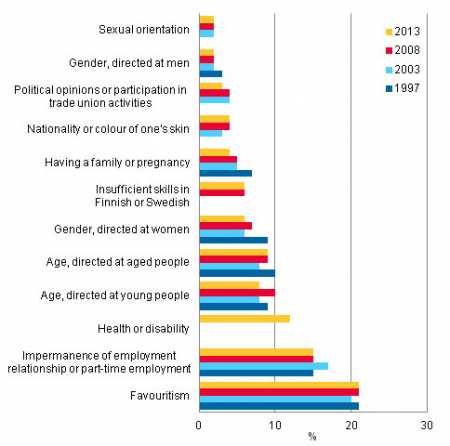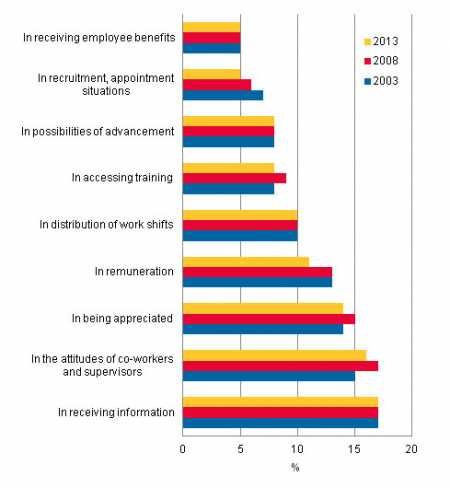|
Wed, 21 May, 2014 12:02:38 AM FTimes Report, May 21  Figure 1. Share of employees that have observed unequal treatment or discrimination at their workplace (%), by grounds for discrimination. Source: Statistics Finland. The preliminary results of Statistics Finland’s Quality of Work Life Survey 2013 show that an increasing number of employees aged under 30 experience discrimination at workplaces.
The survey results, however, draw a cautiously positive picture of decreased gender-related discrimination at work.
Women’s personal experiences of discrimination have decreased over the 2000s, particularly in terms of remuneration. According to the survey, personal experiences of age discrimination at workplaces of persons aged over 50 have also decreased.
On the other hand, an increasing number of employees aged under 30 are experiencing that they are treated unequally due to their young age.
Two per cent of all employees have experienced age discrimination directed at young people and 2 per cent age discrimination directed at aged people.
Examined by age group, it is interesting that among aged people, personal experiences of discrimination directed at old age have decreased but age discrimination experienced by young people has actually increased.
Of persons aged under 30, six per cent (women 5%, men 7%) reported that they had experienced discrimination directed at their young age in 1997, while in 2013 the corresponding share had increased to 8 per cent (women 10%, men 5%).

Figure 2. Has personally experienced unequal treatment or discrimination in the past five years at the workplace. Share (%) of employees by discrimination situation. Source: Statistics Finland. Correspondingly, of employees aged over 50, seven per cent (women 8%, men 6%) reported that they had experienced discrimination directed at their old age in 1997, but only 4 per cent (women 5%, men 2%) in 2013.
Gender-based discrimination directed at women has decreased over the past some 15 years, according to both female and male employees.
According to the survey, this type of discrimination had been detected at the workplace by 6 per cent of employees, while the corresponding figure in 1997 was 9 per cent.
Also, clearly less discrimination based on a person having a family or being pregnant is found today (4%) than in 1997 (7%).
Most commonly, employees have noticed unequal treatment or discrimination based on favouritism, which is reported by one-fifth (21%) of employees.
The second most common (15%) form of discrimination was based on the impermanence of the employment relationship or on part-time employment. In these terms, the situation has remained almost unchanged since 1997.
The third most common form of detected discrimination was based on health or disability (12%), which was inquired in this form for the first time only in 2013.
Table 1. Share of employees that have observed unequal treatment or discrimination at their workplace (%), by gender and grounds for discrimination
More News
|
|
||||||||||||||||||||||||||||||||||||||||||||||||||||||||||||||||||||||||||||||||||||||||||||||||||||||||||||||||||||||||||||||||||||||||||||
Finland Times
| Saturday, 15 November, 2025 |

